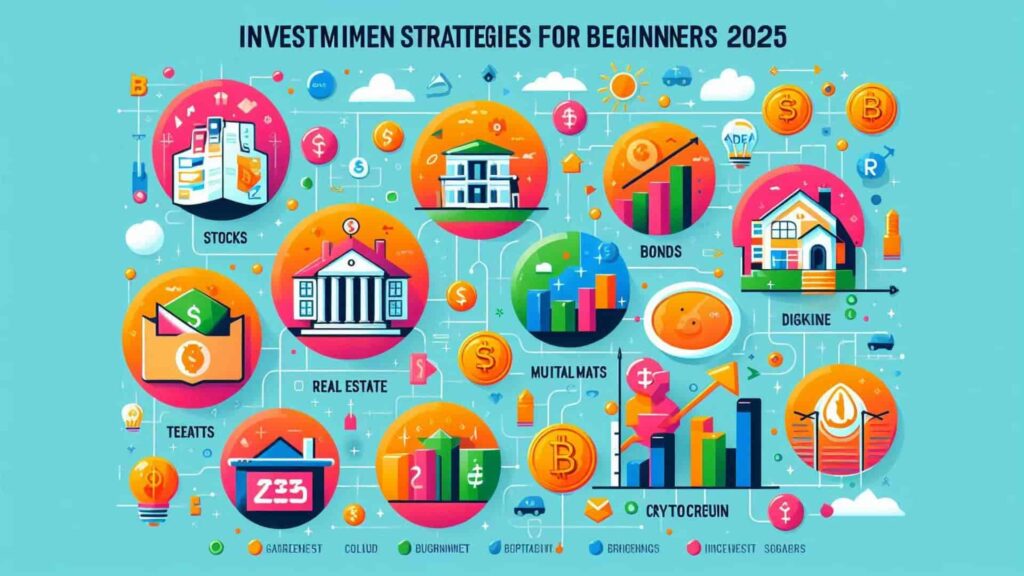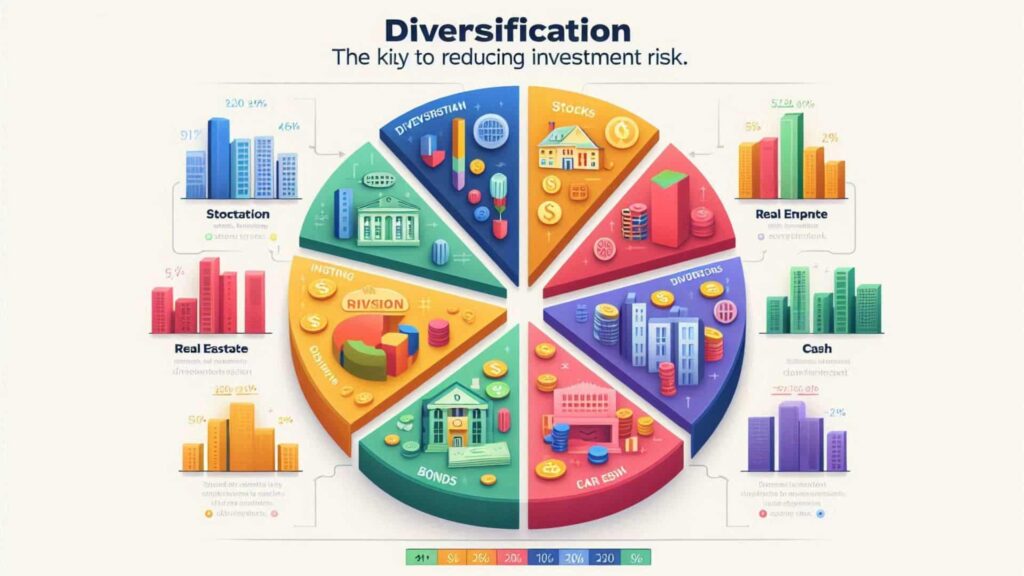
Investing can feel like a big, scary step—especially if you’re just starting out. But trust me, getting into investing in 2025 is not as hard as it sounds. In fact, it’s one of the best decisions you can make for your future. Whether you’re looking to grow your wealth, save for retirement, or just make your money work for you, there are strategies that can help beginners like you get started.
In this guide, we’ll cover the best investment strategies for beginners in 2025, from understanding the basics to building a diversified portfolio. By the end, you’ll feel confident enough to make your first investment.
1. Understanding the Basics of Investing
What is Investing?
Investing is simply the act of putting your money to work with the goal of growing it over time. Instead of letting your cash sit in a savings account, investing gives you the chance to earn a return, or profit, on the money you invest. That return can come from things like stocks, bonds, real estate, or even businesses.
But here’s the catch—investing comes with some risk. The value of your investments can go up or down, depending on the market and the type of investment. Unlike saving, which is low-risk, investing usually carries more risk but also more potential reward.
Key Terms Every Beginner Should Know
Before you dive into investing, it’s important to get familiar with some basic terms. Here are a few you’ll need to know:
- Stock: A share in the ownership of a company. When you buy a stock, you’re essentially buying a piece of that company.
- Bond: A loan you give to a company or government, which pays you back with interest over time.
- Mutual Fund: A pool of money from multiple investors that’s managed by professionals to invest in stocks, bonds, or other securities.
- ETF (Exchange-Traded Fund): Similar to a mutual fund, but ETFs can be bought and sold on stock exchanges.
- Risk Tolerance: How much risk you’re comfortable with when investing. Some people are okay with taking risks for a higher reward, while others prefer safer options.
Understanding these terms is crucial because they form the foundation of your investing journey.
Why Start Investing in 2025?
If you’ve been on the fence about investing, 2025 is a great year to start. The global economy is bouncing back, technology is advancing, and there are plenty of opportunities to grow your money. With inflation rising, keeping your money in a regular savings account won’t help you in the long run. By investing, you’re giving your money a chance to outpace inflation and work harder for you.
2. Setting Financial Goals Before You Invest
Before jumping into the stock market or any other investment, it’s important to set clear financial goals. This will help you choose the right investment strategy.
Short-Term vs. Long-Term Goals
- Short-term goals: These are goals you want to achieve within the next 1-3 years. For example, saving for a vacation or a new car.
- Long-term goals: These are bigger goals that will take 5 years or more to achieve, like saving for a house, retirement, or your child’s education.
Knowing the difference between these goals will help guide your investment decisions. For example, if you have a short-term goal, you may want to invest in safer options like bonds. For long-term goals, you might consider riskier, but higher-reward, investments like stocks.
How to Define Your Financial Goals
When setting your goals, it’s important to make them SMART:
- Specific: Be clear about what you want to achieve (e.g., save $10,000 for a house down payment).
- Measurable: Have a way to track your progress.
- Achievable: Make sure your goals are realistic based on your income and savings.
- Relevant: Ensure that the goal aligns with your personal priorities.
- Time-bound: Set a deadline for when you want to achieve your goal.
Risk Tolerance and Time Horizon
One of the biggest factors in deciding how to invest is your risk tolerance. If you’re okay with ups and downs in the market and can handle risk, you may want to invest in stocks or real estate. But if the thought of losing money keeps you up at night, safer investments like bonds might be a better fit.
Your time horizon—how long you plan to keep your money invested—also matters. The longer you have, the more risk you can take, as you’ll have time to ride out market fluctuations. If you need access to your money in the next couple of years, it’s better to stay on the conservative side.
3. Types of Investments for Beginners in 2025

Now that you understand the basics and have set your financial goals, it’s time to look at the different types of investments available to you in 2025.
1. Stocks
Stocks are one of the most popular ways to invest. When you buy a stock, you’re essentially buying a small piece of a company. If the company does well, your stock value goes up, and you can sell it for a profit. If the company doesn’t do well, you could lose money.
For beginners, investing in stocks can be rewarding—but it comes with risk. It’s essential to start with well-established companies, often referred to as blue-chip stocks. These companies are more stable, though the returns may be slower.
2. Bonds
Bonds are a safer investment compared to stocks. When you buy a bond, you’re loaning money to a company or the government, and they agree to pay you back with interest over time.
Bonds are great for beginners who are risk-averse but still want to see their money grow. They’re also a good option if you have short-term financial goals, as bonds tend to be less volatile than stocks.
3. Mutual Funds and ETFs
If you’re looking for a simple way to diversify your investments, mutual funds and ETFs (Exchange-Traded Funds) are fantastic options for beginners.
- Mutual Funds: These are managed by professionals who pool together money from many investors to buy a collection of stocks, bonds, or other assets. The beauty of mutual funds is that you get instant diversification, which lowers your risk. You don’t have to worry about picking individual stocks; the fund manager does that for you.
- ETFs: ETFs are similar to mutual funds but are traded on the stock exchange like individual stocks. They usually have lower fees than mutual funds and are easy to buy and sell. For beginners, ETFs are a great way to invest in a broad section of the market, like the S&P 500, without the hassle of picking stocks yourself.
Why choose them? Mutual funds and ETFs are ideal for beginners because they spread your money across many investments, lowering your overall risk while still offering growth potential.
4. Real Estate
Investing in real estate is another way to build wealth, and in 2025, it’s still a strong option. You don’t have to buy property outright to get started. With Real Estate Investment Trusts (REITs), you can invest in real estate just like you would in stocks.
- REITs: These are companies that own or finance income-generating real estate. When you invest in REITs, you’re buying shares in these companies, giving you exposure to real estate without the hassle of property management.
Real estate can be a solid investment for long-term growth and is often less volatile than stocks. Plus, real estate tends to appreciate over time, making it a smart choice if you’re looking for both income and capital gains.
5. Cryptocurrencies
Cryptocurrencies have been making headlines for years, and they’re not going away anytime soon. Bitcoin and Ethereum are the most well-known, but there are thousands of others. Cryptos can be incredibly volatile, which means high risk and high reward.
For beginners, the key is to start small and invest only what you’re willing to lose. Crypto is still a speculative investment, but it can be a valuable part of a diversified portfolio, especially with the rise of blockchain technology in 2025.
6. Robo-Advisors
If the idea of managing your own investments feels overwhelming, robo-advisors might be the perfect solution for you. These are automated platforms that build and manage your portfolio based on your financial goals and risk tolerance.
Robo-advisors are ideal for beginners because they require little effort. You simply deposit money, and the robo-advisor invests it for you, typically in low-cost ETFs. Some of the best robo-advisors for 2025 include Betterment, Wealthfront, and SoFi.
4. Diversification: The Golden Rule of Investing

One of the most important lessons every investor should learn is the concept of diversification. If you’re not familiar with the term, it’s simple: Don’t put all your eggs in one basket.
What is Diversification?
Diversification means spreading your investments across different types of assets (like stocks, bonds, real estate, etc.) to reduce your risk. If one investment doesn’t do well, your others might still perform, balancing out your losses.
How Diversification Reduces Risk
Think of diversification like a safety net. If you invest all your money in a single stock and that stock tanks, you could lose everything. But if you spread your money across a mix of stocks, bonds, and other assets, your losses in one area can be offset by gains in another.
How to Build a Diversified Portfolio in 2025
- Mix Asset Classes: A good beginner portfolio should include a mix of stocks (for growth), bonds (for stability), and possibly real estate or even a little cryptocurrency (for diversification).
- Geographic Diversification: Consider investing in international markets, not just domestic stocks, to spread your risk globally.
- Sector Diversification: Don’t invest solely in one industry (like tech). Spread your money across sectors like healthcare, energy, finance, etc.
Common Mistakes Beginners Make with Diversification
One common mistake beginners make is over-diversification, where they invest in too many things, making it hard to keep track. On the other hand, some people fail to diversify enough, putting all their money into one or two investments. Aim for balance, not extremes.
5. Dollar-Cost Averaging: A Smart Investment Approach

If you’ve ever worried about timing the market, you’re not alone. It’s tough to know when to buy and sell, especially as a beginner. That’s where dollar-cost averaging (DCA) comes in.
What is Dollar-Cost Averaging?
Dollar-cost averaging is a strategy where you invest a fixed amount of money on a regular basis, regardless of the market’s ups and downs. This approach allows you to buy more shares when prices are low and fewer shares when prices are high, averaging out your cost over time.
Advantages of Dollar-Cost Averaging for Beginners
The beauty of DCA is that it takes the emotion out of investing. Instead of worrying about whether the market is too high or too low, you stick to your regular investment schedule. This helps you avoid the trap of trying to time the market, which even professional investors struggle with.
How to Implement Dollar-Cost Averaging in 2025
Let’s say you have $5,000 to invest. Instead of putting all of it into the market at once, you could invest $500 each month for 10 months. This way, you’ll gradually build your investment over time, lowering the risk of making a bad decision based on short-term market fluctuations.
6. Tax-Advantaged Accounts: Maximizing Your Returns
Investing is great, but did you know you can reduce your taxes while growing your money? Tax-advantaged accounts like IRAs and 401(k)s are designed to help you save for the future while minimizing your tax burden.
Overview of Tax-Advantaged Accounts
There are two main types of tax-advantaged accounts for most beginners:
- IRA (Individual Retirement Account): You can contribute up to a certain amount each year, and your investments grow tax-deferred (Traditional IRA) or tax-free (Roth IRA).
- 401(k): Offered by many employers, this account allows you to save for retirement with pre-tax dollars, which reduces your taxable income.
Benefits of Tax-Deferred Growth
With tax-deferred accounts like a Traditional IRA or 401(k), you don’t pay taxes on your investment gains until you withdraw the money in retirement. This allows your investments to grow faster than they would in a regular taxable account.
Which Tax-Advantaged Account is Right for You?
- If you think you’ll be in a higher tax bracket when you retire, a Roth IRA is a good choice because you pay taxes now, and your withdrawals are tax-free later.
- If you want to reduce your tax bill this year, a Traditional IRA or 401(k) might be better since contributions are tax-deductible.
7. Emergency Fund: A Must-Have Before You Invest
Before you dive headfirst into the world of investing, it’s essential to have an emergency fund. This safety net protects you from needing to withdraw your investments during financial hardships.
Why an Emergency Fund is Important
The stock market can be volatile, meaning the value of your investments can go up and down. If an unexpected event, like a job loss or medical emergency, happens and you don’t have cash on hand, you may be forced to sell your investments at a loss.
An emergency fund, usually 3 to 6 months’ worth of living expenses, ensures you can handle financial shocks without touching your long-term investments.
Where to Keep Your Emergency Fund
Your emergency fund should be kept in a safe, accessible account—like a high-yield savings account. It’s not meant to be invested in stocks or bonds. You want this money to be there when you need it, without the risk of losing it in the market.
8. Start Small: How Much Should You Invest?
As a beginner, it’s perfectly fine to start small. You don’t need thousands of dollars to get started with investing in 2025. Many brokers allow you to start with as little as $10, and some even offer fractional shares, meaning you can buy a portion of a stock rather than a full share.
How Much Should You Invest as a Beginner?
A good rule of thumb is to start by investing 10-15% of your income, but it’s okay to invest less if that feels more comfortable. The key is to get started and make investing a habit. Over time, as you get more comfortable and your income grows, you can increase the amount you invest.
Automating Your Investments
One of the easiest ways to ensure you stick to your investment goals is by automating your contributions. Set up automatic transfers from your bank account to your investment account each month. This way, you won’t even have to think about it, and you’ll be consistently building your wealth.
9. Avoiding Common Beginner Mistakes
When you’re new to investing, it’s easy to fall into some common traps. Here are a few mistakes to watch out for:
1. Trying to Time the Market
Even seasoned investors struggle to predict when the market will rise or fall. As a beginner, it’s better to stay focused on your long-term goals and avoid jumping in and out of the market based on short-term movements. Dollar-cost averaging (which we discussed earlier) helps you avoid the emotional rollercoaster of trying to time the market.
2. Investing Without a Plan
Going into investing without a clear plan is a recipe for disaster. Before you invest, make sure you’ve set your financial goals, understand your risk tolerance, and have an idea of how long you plan to stay invested (your time horizon). Having a clear plan keeps you from making rash decisions based on fear or hype.
3. Ignoring Fees
Investment fees can eat into your returns over time. Make sure you understand the fees associated with your investments, whether they’re in mutual funds, ETFs, or stocks. Look for low-fee options, especially when investing in mutual funds or ETFs. Even a small difference in fees (like 0.5% versus 1%) can add up to thousands of dollars over the years.
4. Lack of Patience
Building wealth through investing is a long-term game. Many beginners expect quick returns, but the reality is that the market can be unpredictable in the short term. Stay patient and give your investments time to grow. The power of compound interest works best over long periods.
10. Best Platforms and Tools for Beginners in 2025
Now that you have a solid understanding of how to start investing, let’s look at some of the best platforms and tools available for beginners in 2025. Choosing the right broker or platform is important because it will affect things like fees, ease of use, and investment options.
Top Investment Platforms for 2025
Here are a few beginner-friendly platforms you should consider:
- Robinhood: This platform is known for its user-friendly interface and commission-free trades on stocks, ETFs, and crypto. It’s a great option for new investors who want to dip their toes into the stock market without high fees.
- Vanguard: If you’re looking to invest in low-cost ETFs and index funds, Vanguard is a top choice. It’s highly regarded for its low fees and a wide range of investment options.
- Betterment: This is one of the best robo-advisors for beginners. It builds and manages a portfolio based on your risk tolerance and financial goals, making investing hands-off and simple.
- Acorns: Acorns is perfect for beginners who want to start small. It automatically rounds up your everyday purchases and invests the spare change for you. It’s a great way to get started with investing without feeling like you’re making big financial moves.
- Fidelity: A full-service brokerage with a wide range of investment options, from stocks and bonds to ETFs and mutual funds. It offers a low-cost robo-advisor service, as well as financial planning tools.
Investment Tools to Help You Succeed
In addition to choosing the right platform, there are tools that can help you manage and grow your investments:
- Personal Capital: This free tool helps you track your investments and net worth in one place. It also offers retirement planning and portfolio analysis features.
- Morningstar: Use Morningstar’s tools to research stocks, bonds, and mutual funds. They offer ratings and analysis to help you make informed investment decisions.
- Mint: A great budgeting tool that can also help you keep track of your spending, saving, and investing. It’s perfect for beginners who want a clear picture of their overall financial health.
Conclusion: Take the First Step Toward Your Investment Journey in 2025
Investing might seem overwhelming at first, but as you’ve seen, it doesn’t have to be. By starting with the basics, setting clear financial goals, and choosing the right investment strategy for you, you’ll be well on your way to building wealth and securing your future.
Remember, the most important thing is to start—even if it’s small. Over time, your money will grow, and your confidence in investing will increase too. Whether you’re interested in stocks, bonds, real estate, or crypto, there’s no shortage of opportunities in 2025. By following these strategies, you’ll set yourself up for long-term success.

